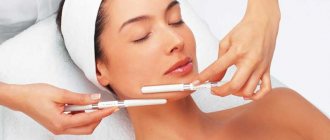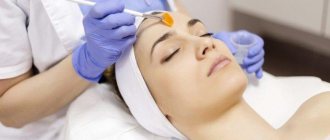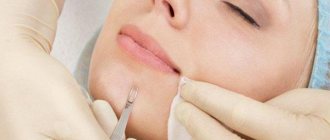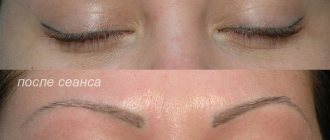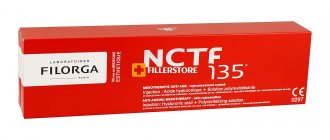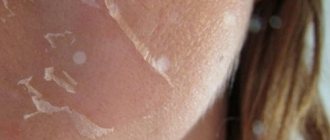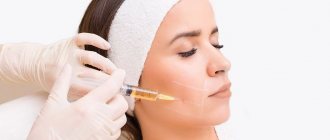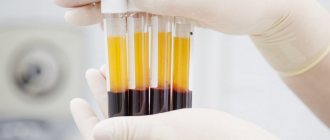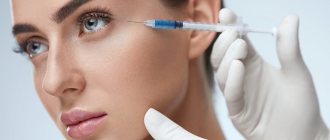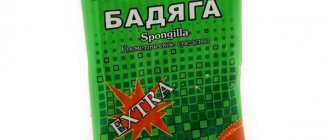What it is?
The procedure for deep cleansing the face using various acids is called chemical peeling. The active ingredients penetrate the skin and exfoliate dead cells. Renewal occurs as a result of regeneration of the epidermis and stimulation of the production of collagen and elastane.
Characteristics and features
Peeling with acids is a chemical burn controlled by a cosmetologist. When it is carried out, it is exposed to substances that destroy not only the top layer of dead cells, but also the deep layers of the epidermis. The main features include :
- you can choose the depth and intensity of exfoliation;
- dead cells dissolve and do not come off as when using a scrub;
- the protective layer of the skin is not damaged;
- Certain types of acids act from the inside when they penetrate the skin.
The effect of the procedure is noticeable immediately and lasts for five to six months.
Age dependence
The cosmetic procedure can be used by girls over 18 years of age for medical reasons. Depending on the age group, the skin is cleansed with various types of peeling:
- At 20–25 years old, the first skin problems may appear: it becomes dull, dry and rough. In this case, a gentle superficial peeling is used using lactic acids - a concentration of up to 40%.
- From 25 to 30 years old, the first small wrinkles and age spots may appear. A superficial type of peeling is used using lactic and glycolic acids. The concentration of the active substance depends on the woman’s age - up to 70%.
- From 30 to 40 years, the dermis becomes less elastic, the number of wrinkles near the eyes increases, and a nasolabial fold appears. The skin becomes dry, as a result of decreased functioning of the sebaceous glands, and other problems appear. For rejuvenation, medium peeling based on lactic, salicylic and retinoic acids is used.
- At 40–50 years old, the skin thins, wrinkles become clearer and pigmentation increases. The tone of the epidermis is reduced, tissues may sag. To stimulate cell function, deep peeling with phenol is used.
Reference . The cosmetologist will select a specific type of peeling that is most suitable for the age and skin type with a certain concentration of the active substance.
Pros and cons: arguments for and against
Benefits of the procedure:
- gentle dissolution of dead skin cells;
- stimulation of collagen and elastane production;
- even out complexion;
- skin rejuvenation;
- fight against wrinkles and age spots;
- treatment of acne, acne;
- stimulation of blood circulation;
- smoothing scars and acne marks;
- correction of age-related changes;
- normalization of the sebaceous glands;
- increasing skin elasticity.
We recommend: Biorevitalization and peeling. Is it possible to do one after the other and after what time?
Disadvantages of peeling include:
- Painful sensations . After exposure to acids, a burn occurs on the skin, which causes discomfort during and after the procedure. If the pain threshold is high, it is recommended to perform peeling with the addition of an anesthetic substance.
- Duration of the recovery period . After a cosmetic procedure, restoration of the dermis occurs within 10–14 days, with deep peeling - up to two months.
- Hyperpigmentation . A possible complication after peeling is the appearance of a dark area on light skin.
- Hypopigmentation . The appearance of a light area after the procedure on dark skin.
- Elimination of exposure to ultraviolet rays . It is forbidden to be in the sun for several months without applying a protective cream.
- Exacerbation of herpes infection . After peeling, herpes rashes may appear.
- Peeling must be carried out in a course . To cleanse and rejuvenate the skin, one procedure is not enough. The effect will be noticeable during the course of treatment.
- Erythema . As a result of the procedure, skin inflammation may occur - redness of the entire face or individual areas. This defect can last for several months.
- Allergic reactions . After exposure to acids, the face becomes red, so it is not easy to recognize an allergy. If swelling lasts for a long time, you should consult a doctor.
After peeling, you must follow the cosmetologist's recommendations to avoid possible complications.
Stages
Facial cleansing involves several stages. Coral scrub does not require any preparatory measures. At the same time, in order to achieve a better result, cosmetologists recommend carrying out yellow peeling of a superficial effect a month before the procedure.
Execution order:
- Inspection and choice of tactics. The specialist assesses the condition of the skin and determines the duration of exposure to the composition. The intensity depends on the problems and the degree of their neglect.
- Cleansing. Removes residues of cosmetics, sebaceous secretions and other contaminants.
- Treatment with a pore opening agent. This will make the process of removing sebaceous plugs and comedones easier. Keep the composition on the face for a short time, then remove the marks with a napkin.
- Applying peeling. The coral composition is evenly distributed over the surface. Perform facial massage for 2-10 minutes. At the same time, the patient feels a slight tingling sensation, which becomes stronger every minute.
- Removing the scrubbing agent.
- Applying a cold bandage. Eases discomfort after the procedure and relieves skin irritation.
- Applying moisturizer. Perform in 10-15 minutes.
Kinds
Acid peeling, depending on the depth of penetration of the active substance, is divided into three types: superficial, medium and deep.
Surface
A soft and gentle peeling that is suitable for patients of any age. During the procedure, only the top layer of dead cells is exfoliated . The procedure is painless and safe. Lactic, malic, citric and tartaric acids are used as active substances that affect the skin.
Indications for superficial peeling include:
- increased skin oiliness;
- acne and enlarged pores;
- facial pigmentation.
Reference . Fruit acids contain substances that increase skin firmness and elasticity.
We invite you to watch a useful video about superficial chemical peeling:
Average
Medium peeling is a controlled burn that peels away the top layer of the epidermis down to the reticular layer. For the procedure, trichloroacetic, retinoic and salicylic acids or gel-like preparations with additives are used. The procedure is used to rejuvenate the skin and eliminate aesthetic problems on the face.
Indications for medium peeling:
- first wrinkles;
- extensive facial pigmentation;
- scars and acne marks;
- loss of elasticity and skin tone.
The procedure must be performed by a cosmetologist-dermatologist.
You can see the detailed procedure for medium chemical peeling here:
Deep
The procedure for exfoliating the deep layers of the epidermis is traumatic and is performed strictly according to indications. Peeling is performed in a hospital under general anesthesia due to the pain of the procedure. Phenol is used as the active substance . After exposure to acid, the deep layers of the epidermis are destroyed, which regenerate within two months.
Indications for deep peeling:
- age-related changes;
- removal of scars and scars.
Deep peeling can have a toxic effect on the body, and problems with the gastrointestinal tract and kidneys may appear.
A brief description of the types of peeling and details of deep chemical peeling is described in this video:
We recommend: Subtleties of pre-peel preparation of facial skin
When is the best time to do a facial peel?
Facial peeling is best done before bed, so that the skin can then rest and there is no need to leave the house after such a thorough cleansing of the skin. The best option is Friday evening, if two free days follow and you can stay at home so as not to expose the epidermis of your face to external natural factors and cosmetics.
You need to do peeling after taking a hot bath or shower, or going to the sauna, when the skin has open pores and is well steamed. The pores of the skin are washed and become most susceptible to external influences.
There are some restrictions on the time of year when exfoliating the epidermis. For example, peeling with fruit acids should not be done in the summer, as it will be difficult to protect against ultraviolet rays, the effects of which should not be allowed on skin cleansed with acids. Facial cleansing procedures can be carried out almost regularly. This allows you to achieve a long-lasting positive effect and maintain excellent facial skin condition all year round.
The best time for peeling is from October to April. The fact is that from autumn to spring the sun's activity is minimal, and the negative effects of ultraviolet radiation on the skin of the face are not so intense. In addition, there is no heat at this time.
Rules for preparing for a procedure in a salon with a cosmetologist
Before peeling, you must visit a cosmetologist for a preliminary consultation. The specialist must be told about the presence of allergic reactions, previous and chronic diseases. Information is needed to identify contraindications, select the active substance for exfoliation and restorative treatment tactics. The cosmetologist will also recommend how to properly prepare for a chemical peel.
Basic rules of preparation:
- 3-4 weeks before the procedure, apply a product containing a small amount of acid to the skin, which the cosmetologist will recommend. Thanks to manipulation, the skin will become thinner, which allows for better penetration of the active substance into the layers of the epidermis during peeling. Seven days before the start of the procedure, stop using the product.
- A week before peeling, it is forbidden to use scrubs or perform actions on the face that could injure the skin.
- If you are prone to herpes rashes, take a course of antiviral drugs.
- For 14 days, avoid exposure to the sun and visiting the solarium.
Reference . Preparation using a product with a low concentration of acid can be replaced by peeling procedures with glycolic or mandelic acid - once or twice.
Contraindications
The effectiveness of chemical peels is very high, but these procedures are not suitable for everyone. There is a whole list of contraindications for which peeling cannot be done:
You can also read: How to do glycolic peeling?
- pregnancy and lactation;
- the presence of skin diseases, wounds, open lesions;
- individual intolerance to the components used for peeling;
- acute stage of the herpes virus;
- infectious diseases;
- neoplasms;
- skin tendency to form keloid scars;
- dermatitis;
- warts;
- cardiovascular diseases;
- diabetes;
- liver or kidney disease.
Chemical peeling is an effective but aggressive procedure. To achieve the best results, it is best to have it done in a salon. The cost of peeling is not too high, and the risk of chemical burns is minimal.
How to do it at home?
When performing chemical peeling at home, observe the following conditions:
- Apply the product only to healthy skin. There should be no pustules, scratches or abrasions.
- Before use, check your skin for an allergic reaction. To do this, apply a little product to the area behind the ear.
- Follow the dosage.
Peeling can be done using pharmaceutical preparations or natural products.
Fruit
Peeling based on fruit acids is gentler compared to salon active substances. A prerequisite before use is to check the skin for an allergic reaction.
Recipes for peeling with fruit acids:
- Pineapple-honey . For the mixture you need to take 100 g of fresh pineapple, 1 tbsp. l. honey and 1 tbsp. l. oatmeal Apply to face, rinse after 8-10 minutes.
- Lemon-butter . Mix rosehip and olive oils, 2 tbsp each. l., add 10–12 drops of lemon juice. Heat the mixture in a water bath and apply to the skin. Rinse off after 7–10 minutes.
- Apple . It is necessary to grind the pulp of apple, cucumber and carrot separately. To cleanse your face, mix the ingredients in a 2:1:1 ratio. Apply to face and neck, rinse after ten minutes.
- Grape with red currants . Take the berries in equal parts, remove the skin and mash. After application, rinse off after 15–25 minutes.
- Orange . For the mixture, take 2 tbsp. l. fruit pulp, add 1 tsp. coffee grounds and 1 tsp. honey Apply to face, rinse after 15 minutes.
Skin cleansing with fruit acids can be carried out in up to 10 procedures.
Reference . Apple contains the most powerful fruit acid, which can cause a burn of the upper layer of the epidermis.
Almond
Peeling based on mandelic acid can be used by girls with thin and sensitive skin prone to the appearance of vascular networks. To cleanse the face at home, use mandelic acid purchased at the pharmacy.
We recommend: Peeling for rosacea. What type of procedure should I choose for sensitive skin?
If mandelic acid is used incorrectly, scars and scars may remain on the skin.
Two weeks before the procedure, apply daily a cream containing mandelic acid with an active substance concentration of 5 to 15%.
Step-by-step procedure:
- Clean your face of cosmetics, wipe with lotion or cosmetic milk.
- For better penetration of mandelic acid, it is necessary to steam the skin. To do this, place a damp, hot cloth on your face.
- Treat skin with toner with 10% mandelic acid.
- For sensitive areas, apply rich cream or Vaseline on the lips and nostrils, around the eyes.
- Apply mandelic acid with a brush, avoiding the eye area. Keep for up to 15 minutes.
- Rinse off any remaining product with warm water.
Reference . When purchasing mandelic acid for peeling, carefully read the attached instructions and follow the indicated dosage.
You will learn how to do almond peeling at home from this video:
Lactic
Peeling based on lactic acid is considered the safest. With its help you can increase skin elasticity and smooth out fine wrinkles. To carry out peeling at home, you need to purchase lactic acid with a concentration of up to 30%. With each subsequent exfoliation, you can increase the amount of active substance.
Stages of the procedure:
- Cleanse your facial skin of cosmetics and fat deposits using lotion and alcohol.
- Apply lactic acid to the face using a cotton pad, avoiding contact with the skin near the eyes.
- For the first procedure, leave the product on the face for 1-1.5 minutes, for the second procedure - 2-2.5 minutes.
- Wash off after the specified time.
- Apply a light texture moisturizer to your face.
Peeling can be done using natural dairy products:
- Milk serum . Mix 3 tbsp. l. solution with 1 tbsp. l. instant coffee. Apply the mixture to the face, rinse after 15 minutes.
- Cottage cheese . Mix 2 tbsp. l. cottage cheese and 2 tbsp. l. serum. Apply the mixture in circular motions to your face. Wash off after 10 minutes.
- Kefir . Pour kefir over a piece of rye bread and knead. Apply the paste to your face and leave for 10 minutes. After the specified time, wash off.
Reference . Do not perform milk peeling during pregnancy, herpes rashes, pustules and wounds on the face.
Advantages and disadvantages
The procedure has its positive and negative sides, the details are indicated in the table below.
| pros | Minuses |
|
|
How often can I do it?
How often the procedure can be performed depends on the type of peeling.:
- Superficial . The peeling course is 4–10 times. The procedure should be carried out no more than once every 10 days.
- Average . Peeling course - 1-3 times, between each procedure - a month.
- Deep . The procedure is performed once. Peeling can be repeated no earlier than after one year.
Chemical peeling is a procedure for cleansing the skin from the superficial to the deep layer of the epidermis. Depending on the skin problem and the woman’s age, the cosmetologist selects the type of cleansing, the composition of the product and the concentration of the active substance.
Mechanical peeling of facial skin
Mechanical peeling is carried out using various attachments on instruments or natural abrasives. The process removes the damaged top layer of skin. Together with them, shallow wrinkles, skin defects, and unevenness are eliminated.
There are several options for mechanical peeling:
- Coral professional peeling cleanses the skin using crushed coral particles. The essence of this treatment is that a mass containing highly crushed coral and beneficial herbs is applied to the face. To obtain the effect, a minimum of four sessions are required. After which the skin on the face becomes soft and smooth. Peeling does not cause significant damage to the skin, since it contains essential oils and sea salt, it works as an antiseptic;
- Among other methods of mechanical exfoliation of the epidermis, diamond peeling is the most gentle, painless and one of the most effective. This procedure is performed using special attachments. Moreover, the result is visible after just a few sessions - the skin becomes smoother and fresher. The secret of this result is that the cleansing substance is microscopically small, so it cleanses dead cells very well without damaging the skin.
